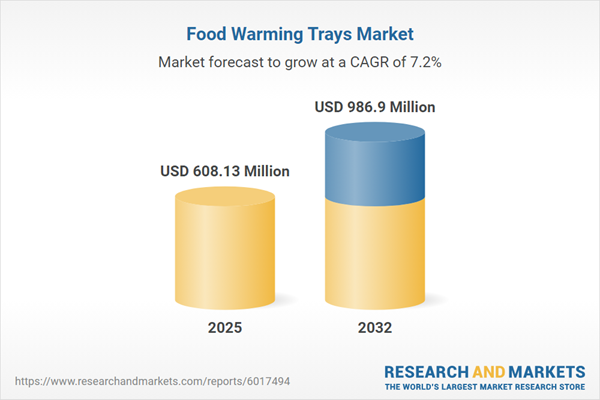Speak directly to the analyst to clarify any post sales queries you may have.
The food warming trays market is evolving rapidly as businesses seek efficient, safe, and technologically advanced solutions for food presentation across diverse commercial and institutional environments. This report equips senior decision-makers with a strategic view of current trends, innovation drivers, and the regional dynamics shaping procurement, sourcing, and operational planning in the global food warming tray sector.
Market Snapshot: Food Warming Trays Market Size and Outlook
The food warming trays market grew from USD 566.54 million in 2024 to USD 608.13 million in 2025. It is expected to continue growing at a CAGR of 7.18%, reaching USD 986.90 million by 2032. This market expansion reflects heightened demand in healthcare, hospitality, and food service channels, along with a shift toward energy-efficient, programmable, and digitally integrated warming solutions. Regulatory changes, regional tariff impacts, and evolving end-user demands are driving procurement strategies and influencing product innovation across all levels of the industry.
Scope & Segmentation: Understanding the Diverse Landscape
This report provides detailed segmentation and comprehensive analysis of the food warming trays market, covering key areas:
- Product Types: Electric (double plate, single plate), induction (multi point, single point), infrared (ceramic, quartz), and steam-based (dry steam, wet steam).
- End Users: Hospitals and healthcare (clinics, hospitals), hotels and resorts (budget, luxury), households, and restaurants (full service, quick service).
- Applications: Commercial use (banquet, buffet, catering), home use (buffet, table warming), and outdoor use (camping, events, picnics).
- Capacity Options: Double tray (split, standard), multi tray (four tray, three tray), and single tray (compact, standard).
- Distribution Channels: E-tailers, manufacturer websites, hypermarkets, supermarkets, and specialty stores.
- Materials: Aluminum (lightweight conduction), ceramic (surface durability), and stainless steel (corrosion resistance).
- Temperature Control Technologies: Manual control, programmable digital interfaces, and thermostatic systems.
- Geographic Regions: Americas (North America, Latin America), Europe, Middle East & Africa, and Asia-Pacific, encompassing major developed and emerging markets.
- Leading Companies: Coverage includes Hatco Corporation, The Vollrath Company, Nemco Food Equipment Company, Winco Holdings, Cambro Manufacturing, Adcraft Tableware, FWE, Cadco, Hamilton Beach Brands, Star Manufacturing International, and others.
Key Takeaways: Strategic Insights for Senior Leaders
- Technological innovation is shifting market demand from basic electric trays to programmable, induction- and infrared-powered models that prioritize safety and precise temperature control.
- Healthcare, hospitality, and food service sectors show rising preference for hygienic ceramic surfaces and modular designs that facilitate fast, safe food handling and high-volume service.
- US tariff adjustments have prompted a move toward localized sourcing, reshaping global supply chains. Providers investing in domestic assembly and regionally sourced materials gain resilience and cost control.
- Collaborations between manufacturers and material scientists have resulted in warming trays with improved energy efficiency, durability, and customizable aesthetics, meeting client requirements across premium and budget segments.
- Value-added services, such as installation support, staff training, and maintenance programs, are increasingly important for building long-term customer loyalty and driving repeat business in institutional settings.
Tariff Impact: Navigating the 2025 US Trade Environment
The implementation of US tariffs on warming tray components and finished products in 2025 has driven strategic shifts toward local manufacturing, dual-sourcing, and regional vendor partnerships. This realignment enhances supply chain agility, mitigates risk, and supports competitive pricing strategies. Stakeholders are adjusting contract models and exploring diversified supplier networks to maintain continuity regardless of future trade policy shifts.
Methodology & Data Sources
This report utilizes a rigorous methodology that blends in-depth primary interviews with product development leads, procurement executives, and facility managers, along with secondary research into regulatory, technical, and trade data. Analytical accuracy is ensured through data triangulation, comparative cost modeling, and scenario planning, providing a holistic market perspective with actionable strategic insights.
Why This Report Matters: Benefits for Senior Decision-Makers
- Gain clarity on regional product preferences, enabling optimized inventory and procurement strategies.
- Identify emerging trends in digitization, energy efficiency, and design that can drive competitive differentiation.
- Enhance strategic sourcing decisions by understanding tariff impacts, supply chain risks, and go-to-market opportunities.
Conclusion
By leveraging the comprehensive insights in this report, industry leaders can anticipate change, drive operational efficiency, and sustain growth in a fast-evolving market for food warming trays.
Additional Product Information:
- Purchase of this report includes 1 year online access with quarterly updates.
- This report can be updated on request. Please contact our Customer Experience team using the Ask a Question widget on our website.
Table of Contents
3. Executive Summary
4. Market Overview
7. Cumulative Impact of Artificial Intelligence 2025
Companies Mentioned
The companies profiled in this Food Warming Trays market report include:- Hatco Corporation
- The Vollrath Company, L.L.C.
- Nemco Food Equipment Company, LLC
- Winco Holdings, Inc.
- Cambro Manufacturing Company
- Adcraft Tableware Company
- FWE, Inc.
- Cadco, Inc.
- Hamilton Beach Brands, Inc.
- Star Manufacturing International Limited
Table Information
| Report Attribute | Details |
|---|---|
| No. of Pages | 187 |
| Published | October 2025 |
| Forecast Period | 2025 - 2032 |
| Estimated Market Value ( USD | $ 608.13 Million |
| Forecasted Market Value ( USD | $ 986.9 Million |
| Compound Annual Growth Rate | 7.1% |
| Regions Covered | Global |
| No. of Companies Mentioned | 11 |









